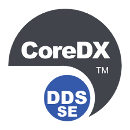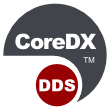CoreDX DDS on a DSP!
 |
Phone: 720.733.7906 Fax:866.725.4485 755 Maleta Lane, Suite 203 Castle Rock, CO 80108 contact@twinoakscomputing.com www.twinoakscomputing.com |
 |
February Newsletter 2013 Welcome to the Twin Oaks Computing, Inc Newsletter! Our monthly newsletter brings you news and information about Twin Oaks Computing and our CoreDX DDS middleware. Be sure to "like", "follow" and "friend" us on our Social Networking sites for fun facts, free giveaways, and stories about Communications Middleware, Technology, and Twin Oaks Computing. CoreDX DDS Communicates on Digital Signal Processors Over recent years we have seen a shift in DSP application. While early DSPs were used for specialized, independent purposes, today's DSPs are part of larger, connected components. Today DSPs need to communicate and interoperate with GPPs, FPGAs, and other DSPs. Software must manage these highly interconnected communications and interoperability issues, while still delivering optimal performance and reliability. It's not surprising that as more processing is pushed to DSPs; developers want the functionality and convenience of a middleware like DDS. For more information about CoreDX DDS and DSP, click here... We now have over 1500 likes on Facebook! A big THANK YOU to all of our fans! We post articles, cartoons, and random facts daily. You can even answer simple trivia questions for your chance to win a free flash drive. "like" us on Facebook to see what all of the fun is about! Frequently Asked Question: Content Filters Question:I remember reading somewhere that CoreDX DDS can apply content filters at the writer or reader, is this true? How can I configure the content filters? Answer:You are correct! CoreDX DDS can apply content filters at the DataWriter or the DataReader, and in fact, the application can configure where filters are applied. This is done using a QoS policy on the DataWriter: CoreDX_RTPSWriterQoSPolicy.apply_filters. When this option has a value of '1' or 'true' (which is the default), the DataWriter filters the data appropriately for all matched DataReaders. When this option has a value of '0' or 'false', the filtering happens on the DataReader. This configuration has an impact on how data is communicated between the DataWriter and DataReaders, and the best configuration is dependent on your communications architecture (the number of DataReaders matched to this DataWriter, and the amount of data that is filtered for each DataReader). When content filters are applied at the DataWriter, and at least one matched DataReader has a content filter configured, the DataWriter will use UNICAST communications to all matched DataReaders, to ensure the appropriate data samples reach the appropriate DataReaders. This may or may not result in less network traffic than applying the content filters at the DataReaders. Click here to learn more More Upcoming Events March 19, 2013 Real Time Embedded Computing Conference, Dallas, TX, USA. Read more... March 18-21, 2013 OMG DDS Days, Reston, VA, USA. Read more... March 22, 2013 Real Time Embedded Computing Conference, Austin, TX, USA. Read more... April 22-25, 2013 Design West, Silicon Valley, CA, USA. Read more... May 21-22, 2013 DevCon 2013, Santa Clara, CA, USA. Read more... June 18, 2013 Real Time Embedded Computing Conference, Denver, CO, USA. Read more... For more information about Twin Oaks Computing: "Follow" us on Twitter... "Like" us on Facebook... View Twin Oaks Computing on Pinterest... View Twin Oaks Computing Power Point Presentations discussing everything from Android to Interoperability on Slideshare...
|







